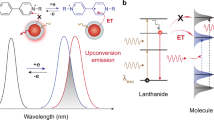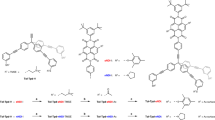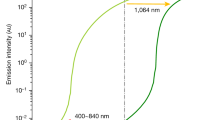Abstract
Bringing together compounds of intrinsically different functionality, such as inorganic nanostructures and organic molecules, constitutes a particularly powerful route to creating novel functional devices with synergetic properties found in neither of the constituents. We introduce nanophotonic functional elements combining two classes of materials, semiconductor nanocrystals1 and dyes, whose physical nature arises as a superposition of the properties of the individual components. The strongly absorbing rod-like nanocrystals2 focus the incident radiation by photopumping the weakly absorbing dye via energy transfer. The CdSe/CdS nanorods exhibit a large quantum-confined Stark effect3 on the single-particle level, which enables direct control of the spectral resonance between donor and acceptor required for nanoscopic Förster-type energy transfer in single nanorod–dye couples. With this far-field manipulation of a near-field phenomenon, the emission from single dye molecules can be controlled electrically. We propose that this effect could lead to the design of single-molecule optoelectronic switches providing building blocks for more complex nanophotonic circuitry.
This is a preview of subscription content, access via your institution
Access options
Subscribe to this journal
Receive 12 print issues and online access
$259.00 per year
only $21.58 per issue
Buy this article
- Purchase on Springer Link
- Instant access to full article PDF
Prices may be subject to local taxes which are calculated during checkout



Similar content being viewed by others
References
Alivisatos, A. P. Semiconductor clusters, nanocrystals, and quantum dots. Science 271, 933–937 (1996).
Talapin, D. V. et al. Highly emissive colloidal CdSe/CdS heterostructures of mixed dimensionality. Nano Lett. 3, 1677–1681 (2003).
Müller, J. et al. Wave function engineering in elongated semiconductor nanocrystals with heterogeneous carrier confinement. Nano Lett. 5, 2044–2049 (2005).
Nirmal, M. et al. Fluorescence intermittency in single cadmium selenide nanocrystals. Nature 383, 802–804 (1996).
Willard, D. M., Carillo, L. L., Jung, J. & Van Orden, A. CdSe-ZnS quantum dots as resonance energy transfer donors in a model protein-protein binding assay. Nano Lett. 1, 469–474 (2001).
Kloepfer, J. A., Cohen, N. & Nadeau, J. L. FRET between CdSe quantum dots in lipid vesicles and water- and lipid-soluble dyes. J. Phys. Chem. B 108, 17042–17049 (2004).
Ebenstein, Y., Mokari, T. & Banin, U. Quantum-dot-functionalized scanning probes for fluorescence-energy-transfer-based microscopy. J. Phys. Chem. B 108, 93–99 (2004).
Hohng, S. & Ha, T. Single-molecule quantum-dot fluorescence resonance energy transfer. ChemPhysChem. 6, 956–960 (2005).
Medintz, I. L. et al. A fluorescence resonance energy transfer-derived structure of a quantum dot-protein bioconjugate nanoassembly. Proc. Natl Acad. Sci. USA 101, 9612–9617 (2004).
Müller, F. et al. Investigation of energy transfer between CdTe nanocrystals on polystyrene beads and dye molecules for FRET-SNOM applications. J. Phys. Chem. B 108, 14527–14534 (2004).
Potapova, I. et al. CdSe/ZnS nanocrystals with dye-functionalized polymer ligands containing many anchor groups. Angew. Chem. Int. Edn 44, 2437–2440 (2005).
Zhang, C.-Y., Yeh, H.-C., Kuroki, M. T. & Wang, T.-H. Single-quantum-dot-based DNA nanosensor. Nature Mater. 4, 826–831 (2005).
Kiraz, A., Ehrl, M., Bräuchle, C. & Zumbusch, A. Low temperature single molecule spectroscopy using vibronic excitation and dispersed fluorescence detection. J. Chem. Phys. 118, 10821–10824 (2003).
Orrit, M., Bernard, J., Zumbusch, A. & Personov, R. I. Stark effect on single molecules in a polymer matrix. Chem. Phys. Lett. 196, 595–600 (1992).
Empedocles, S. A. & Bawendi, M. G. Quantum-confined Stark effect in single CdSe nanocrystallite quantum dots. Science 278, 2114–2117 (1997).
Rothenberg, E., Kazes, M., Shaviv, E. & Banin, U. Electric field induced switching of the fluorescence of single semiconductor quantum rods. Nano Lett. 5, 1581–1586 (2005).
Heilemann, M., Margeat, E., Kasper, R., Sauer, M. & Tinnefeld, P. Carbocyanine dyes as efficient reversible single-molecule optical switch. J. Am. Chem. Soc. 127, 3801–3806 (2005).
Wagner, R. W., Lindsey, J. S., Seth, J., Palaniappan, V. & Bocian, D. F. Molecular optoelectronic gates. J. Am. Chem. Soc. 118, 3996–3997 (1996).
Xu, Q.-H. et al. The fluorescence resonance energy transfer (FRET) gate: A time-resolved study. Proc. Natl Acad. Sci. USA 102, 530–535 (2005).
White, S. S., Ying, L., Balasubramanian, S. & Klenerman, D. Individual molecules of dye-labeled DNA act as a reversible two-color switch upon application of an electric field. Angew. Chem. Int. Edn 43, 5926–5930 (2004).
Franzl, T., Klar, T. A., Schietinger, S., Rogach, A. L. & Feldmann, J. Exciton recycling in graded gap nanocrystal structures. Nano Lett. 4, 1599–1603 (2004).
Crooker, S. A., Hollingsworth, J. A., Tretiak, S. & Klimov, V. I. Spectrally resolved dynamics of energy transfer in quantum-dot assemblies: Towards engineered energy flows in artificial materials. Phys. Rev. Lett. 89, 186802 (2002).
Calzaferri, G., Huber, S., Maas, H. & Minkowski, C. Host-guest antenna materials. Angew. Chem. Int. Edn 42, 3732–3758 (2003).
Hecht, S. & Fréchet, J. M. J. Dendritic encapsulation of function: Applying nature’s site isolation principle from biomimetics to materials science. Angew. Chem. Int. Edn 40, 74–91 (2001).
Fleming, G. R. & Scholes, G. D. Quantum mechanics for plants. Nature 431, 256–257 (2004).
McQuade, D. T., Pullen, A. E. & Swager, T. M. Conjugated polymer-based chemical sensors. Chem. Rev. 100, 2537–2574 (2000).
Acknowledgements
We would like to thank A. Susha for helpful discussions and W. Stadler and A. Helfrich for technical assistance. Financial support by the Volkswagen Stiftung and the Deutsche Forschungsgemeinschaft through the Gottfried Wilhelm Leibniz award and the Sonderforschungsbereich 486 is gratefully acknowledged. Work at the Molecular Foundry was supported by the U S Department of Energy under Contract No. DE-AC02-05CH11231.
Author information
Authors and Affiliations
Corresponding author
Ethics declarations
Competing interests
The authors declare no competing financial interests.
Supplementary information
Supplementary Information
Supplementary information and figures S1-S13
Rights and permissions
About this article
Cite this article
Becker, K., Lupton, J., Müller, J. et al. Electrical control of Förster energy transfer. Nature Mater 5, 777–781 (2006). https://doi.org/10.1038/nmat1738
Received:
Accepted:
Published:
Issue Date:
DOI: https://doi.org/10.1038/nmat1738
This article is cited by
-
Dynamic upconversion multicolour editing enabled by molecule-assisted opto-electrochemical modulation
Nature Communications (2021)
-
Electro-optic switch based on near-field-coupled quantum dots
Applied Physics A (2014)
-
Carrier multiplication in semiconductor nanocrystals detected by energy transfer to organic dye molecules
Nature Communications (2012)
-
Plasmonic beaming and active control over fluorescent emission
Nature Communications (2011)



